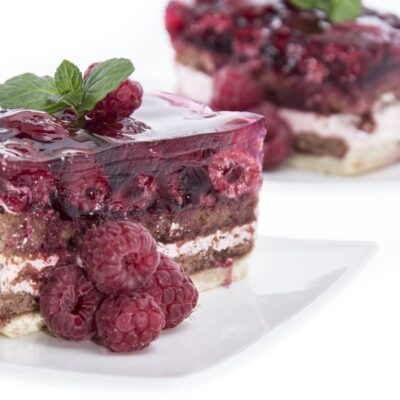Origin2
Originally, gelatin was a luxury food item, finding use in jelly dishes for aristocrats and royalty such as Henry VIII of England (1491-1547). Then, during the Napoleonic era with the invention of the pressure cooker, it served as a source of protein when meat was scarce. The pressure cooker could soften bones and produce a stock for soup as well as gelatin for protein.
By 1890, Charles Knox was making packs of granular gelatin consumers could use at home and in 1897 Peter Cooper improved upon Knox’s product and developed what is now known as JELL-O™.
Function
Some of its functional properties in bakery applications include:
| Function | Application |
| Whipping Agent | Chiffon fillings, whipped creams |
| Stabilizers (prevents separation) | Frostings and icings |
| Thickener | Jellies, fillings and syrups |
| Adhesive agent | Binds icings to baked goods |
| Protective Colloid in saturated solutions | Restricts sugar crystal growth in icings |
Nutrition
Gelatin is approximately 87-92% protein and the remainder is water and minerals. It contains all essential amino acids except tryptophan.3
Commercial Production
Gelatin is made from many different sources of collagen, primarily: cattle bones, hides, pig skins, and fish. Pig skin and cattle hide are a large source of food grade options.
Gelatin is prepared from soluble collagen by enzymatic, acidic or basic hydrolysis. Collagen from cow undergoes both acid and alkali treatment, while collagen from pig skin undergoes acid treatment. After hydrolysis, the gelatin is further processed with hot water extraction, deionization, evaporation filtration, sterilization, extruding, drying and milling.3
Application
Gelatin for food applications is chosen based on bloom size and type. Bloom is a function of molecular weight and predicts the gelling behavior. Some examples of use in application:1
| Food | Percent use | Bloom |
| Marshmallows | 1.7-2.5% | 225-275 |
| Gelatin dessert | 7-9% | 175-275 |
| Fillings & icings | 1-2% | 225-250 |
FDA regulations
Gelatin has a long history of use in food with no documented deleterious effects. In 1975, the Select Committee on GRAS substances (SCOGS) concluded there is no evidence of harm at current or expected use level and is therefore considered GRAS (Generally Recognized as Safe).4
References
- GMIA. Gelatin Handbook. 2012. www.gelatin-gmia.com/images/GMIA_Gelatin_Manual_2012.pdf. Accessed on 28 Jan 2019.
- Schrieber, R, Gareis, H.”Introduction”, Gelatine Handbook: Theory and Industrial Practice. Wiley, Germany, 2007.
- Moriod, AA, Adam, HF. “Review: Gelatin, Source, Extraction and Industrial Applications”. Acta Sci Pol. Technol Aliment. 12(2), 2013, pp. 135-147.
- U.S. FDA. Select Committee on GRAS Substances Opinion: Gelatin. wayback.archive-it.org/7993/20171031062708/https://www.fda.gov/Food/IngredientsPackagingLabeling/GRAS/SCOGS/ucm261307.htm . Accessed 28 Jan 2019.

